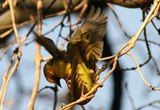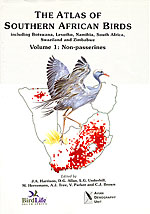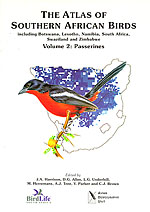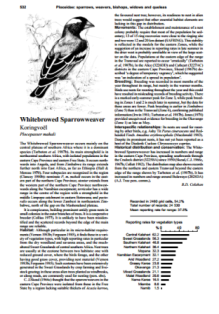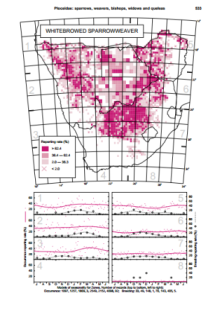Weaver news
| Harrison JA, Allan DG, Underhill LG, Herremans M, Tree AJ, Parker V, Brown CJ (eds). 1997. The Atlas of Southern African Birds. Volume 1: Non-passerines, and Volume 2: Passerines. BirdLife South Africa, Johannesburg This atlas contains the most up-to-date information on the distribution of birds in southern Africa, and probably all bird field guides for the region use maps based on these atlas maps. Figure (below): The dustjackets of the Atlas feature the Blue Crane and Red-backed Shrike.
Volume 1 (c. 900 pages) contains the introductory chapters and the non-passerine texts. The introductory chapters describe the methodology, and the `avi'-geography of southern Africa. This chapter iinclues selected habitat photographs that represent the wide diversity of habitat types in southern Africa. Volume 2 (c. 700 pages) contains the passerine texts. 500 species receive two (or sometimes three) pages of texts, maps and seasonality figures; 200 species are covered with map and text on a single page. For each species, statistics provide a convenient summary of the data and a measure of the relative abundance within the range. For 200 vagrant species there is no map, but a paragraph of text giving details of occurrence in the region. SABAP1 notes and links to pdfs of the introduction, geography and references - see here .
25 weaver species are covered in the main text. Most of these have two pages per species, but the Chestnut Weaver, Red-headed Quelea, Black-winged Bishop and Yellow-backed Widow have one page; the Red-billed Quelea has three pages. Two weavers are given a paragraph of text in the vagrants section: Olive-headed Weaver and Cardinal Quelea. The weaver texts with maps and figures may be downloaded here as pdfs (all species texts are available at ADU SABAP2 web - click on a species, or search for one, and the pdf link is on the side menu).
The weaver pdfs may be downloaded here (some English names have been updated here):
The distribution of South African birds is being updated by the SABAP2 project. The weavers with the greatest changes in distribution between the two Atlas projects are the Red-billed Quelea (see a href="newstable.php?id=210">here) and Thick-billed Weaver (see a href="newstable.php?id=104">here). Read more about African bird atlasses. Literature as featured in Weaver Watch news items |








